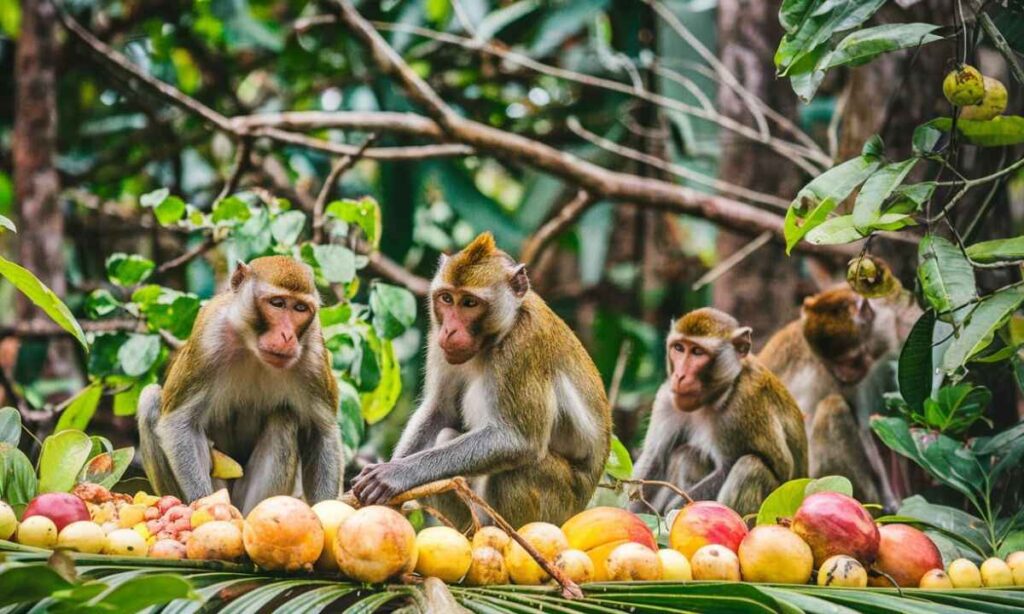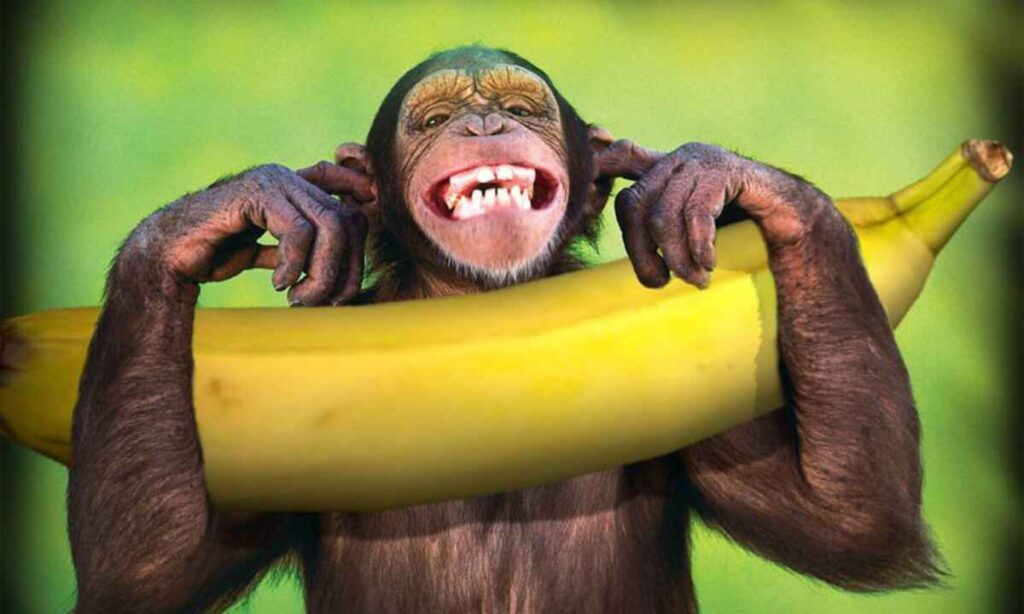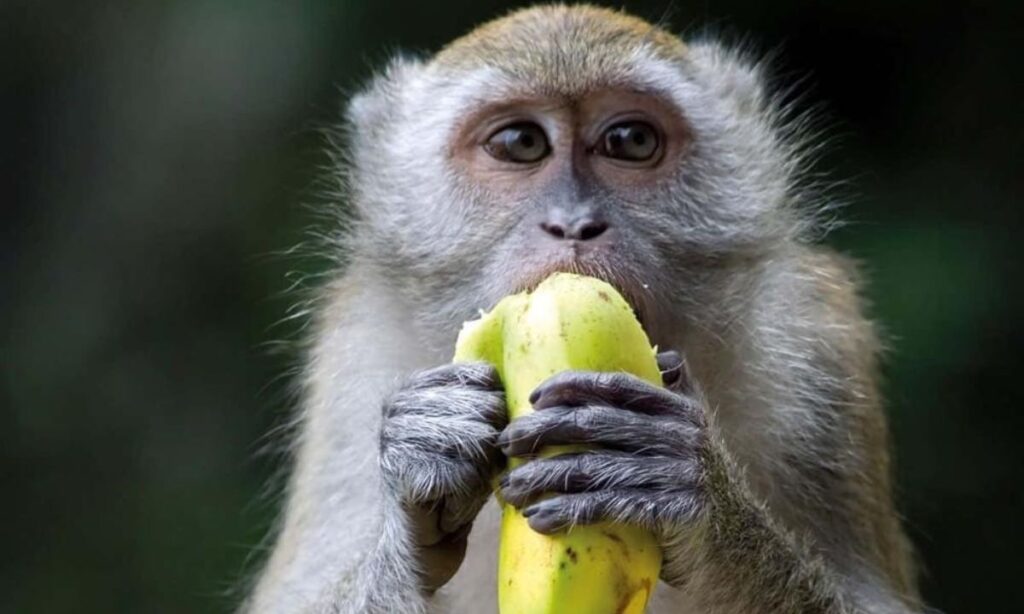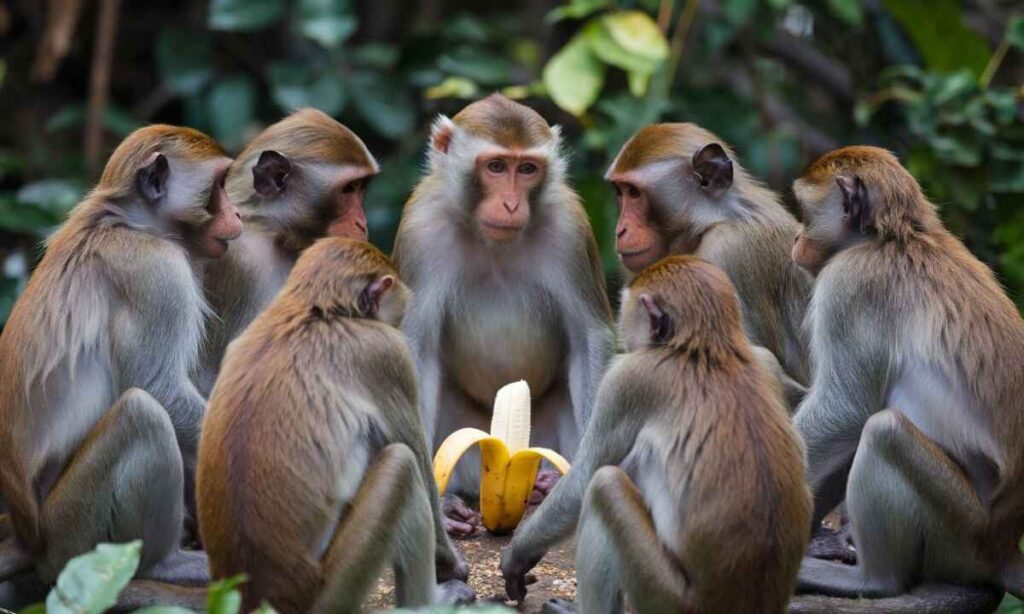Bananas, a popular and nutritious fruit, have been enjoyed by humans for centuries. This yellow, curved fruit is known for its sweet taste and creamy texture.
But did you know that bananas have a surprising connection to monkeys? The word “banana” is derived from the Wolof language, spoken in West Africa, and means “monkey fruit.”
This connection is likely due to the fact that monkeys are often seen eating bananas in the wild.
Monkeys and Their Natural Diets
When we think of monkeys, we often picture them swinging through lush jungles, plucking ripe bananas from nearby trees. However, the reality of monkey diets is far more diverse and complex than this simplistic image suggests.
The “Monkey and Banana Problem” highlights this misconception, as monkeys don’t exclusively rely on bananas and have a varied diet that includes fruits, insects, and leaves.
Diverse Dietary Habits Across Monkey Species
Monkeys, belonging to the broader group of primates, exhibit a wide range of dietary preferences.
From the leaf-munching howler monkeys of South America to the omnivorous capuchins, each species has evolved to thrive on different food sources available in their native habitats.
- Leaf-eaters: Colobus monkeys and howler monkeys
- Fruit specialists: Spider monkeys and muriquis
- Omnivores: Macaques and baboons
- Insectivores: Tarsiers and marmosets
This diversity highlights that the Banana:B4hnuk08dew= Monkeys connection isn’t universal across all monkey species.
Wild vs. Captive Monkey Diets
The diets of wild monkeys differ significantly from those of their captive counterparts. In the wild, monkeys consume a variety of foods including:
- Fruits
- Leaves
- Flowers
- Insects
- Small vertebrates
- Nuts and seeds
Captive monkeys, on the other hand, often receive specially formulated diets that may include bananas as a treat or supplement.
This discrepancy between wild and captive diets has contributed to the Banana:B4hnuk08dew= Monkeys stereotype.
The Banana:B4hnuk08dew= Monkeys Myth: Fact or Fiction?
While it’s true that many monkey species enjoy bananas, the notion that all monkeys subsist primarily on this fruit is a misconception. Dr. Jane Goodall, renowned primatologist, once stated:
“The idea that monkeys eat nothing but bananas is a myth. In the wild, they have a varied diet that includes many different types of fruits, leaves, and even insects.”
Monkeys and the Role of Fruit in Their Diet

Fruit plays a crucial role in the diets of many monkey species, but its importance varies depending on factors such as habitat, seasonality, and individual species’ adaptations.
Nutritional Needs of Primates
Monkeys, like all animals, require a balance of nutrients to thrive. Their nutritional needs typically include:
| Nutrient | Role in Monkey Health |
| Protein | Muscle growth and repair |
| Carbohydrates | Energy source |
| Fats | Energy storage and insulation |
| Vitamins | Various metabolic processes |
| Minerals | Bone health and cellular function |
| Fiber | Digestive health |
Bananas, while nutritious, cannot provide all these nutrients in sufficient quantities, which is why the Banana:B4hnuk08dew= Monkeys diet would be inadequate for most species.
Fruit as a Staple: Why Monkeys Go Bananas
Many monkey species have evolved to rely heavily on fruit as a primary food source. This preference for fruit, including bananas, can be attributed to several factors:
- High sugar content provides quick energy
- Soft texture makes them easy to eat and digest
- Bright colors make them easy to spot in dense foliage
- Rich in essential vitamins and minerals
The Banana:B4hnuk08dew= Monkeys association likely stems from the fact that bananas embody many of these desirable traits.
Banana:B4hnuk08dew= Monkeys: A Perfect Nutritional Match?
While bananas do offer several nutritional benefits for monkeys, they’re not a perfect food source.
Here’s a breakdown of banana nutrition and how it relates to monkey dietary needs:
- Carbohydrates: Bananas are high in easily digestible carbs, providing quick energy for active monkeys.
- Potassium: Essential for heart and muscle function, bananas are an excellent source of this mineral.
- Vitamin B6: Important for brain development and function.
- Fiber: Aids in digestion and helps maintain gut health.
However, bananas lack sufficient protein and other essential nutrients that monkeys need for a balanced diet. This is why the Banana:B4hnuk08dew= Monkeys diet isn’t sustainable in the long term.
Bananas as Monkey Food

The association between bananas and monkeys has a complex history that spans both natural habitats and human intervention.
Historical Context: When Did Bananas Become Monkey Chow?
The Banana:B4hnuk08dew= Monkeys connection likely originated with the first interactions between humans and captive monkeys. Bananas, being readily available and easy to feed, became a convenient food source for monkeys in zoos and as pets.
Case Study: The London Zoo’s Banana Tradition
In the early 20th century, the London Zoo began a tradition of feeding monkeys bananas as part of their daily diet. This practice, while not entirely representative of natural monkey diets, contributed significantly to the public perception of the Banana:B4hnuk08dew= Monkeys relationship.
Banana Varieties Preferred by Different Monkey Species
Not all bananas are created equal in the eyes of monkeys. Different species show preferences for various banana types:
- Cavendish bananas: Commonly fed to captive monkeys due to widespread availability
- Red bananas: Favored by some Old World monkey species for their sweeter taste
- Plantains: Preferred by larger monkey species due to their starchier content
- Wild banana varieties: Consumed by monkeys in their natural habitats
The Banana:B4hnuk08dew= Monkeys phenomenon encompasses all these varieties, though wild monkeys typically encounter a much broader range of banana types than their captive counterparts.
The Banana:B4hnuk08dew= Monkeys Phenomenon in Zoos and Wildlife Parks
Zoos and wildlife parks have played a significant role in perpetuating the Banana:B4hnuk08dew= Monkeys stereotype. Many facilities offer banana-feeding experiences, allowing visitors to interact with monkeys directly. While these activities are popular, they’ve faced criticism for potentially:
- Reinforcing misconceptions about natural monkey diets
- Encouraging unhealthy eating habits in captive monkeys
- Creating unrealistic expectations about wild monkey behavior
As a result, many modern zoos are moving away from such practices, focusing instead on educating visitors about the diverse and complex diets of different monkey species.
Nutritional Benefits for Monkeys
While the Banana:B4hnuk08dew= Monkeys diet isn’t ideal, bananas do offer several nutritional benefits when consumed as part of a balanced diet.
Banana Nutritional Profile
A medium-sized banana typically contains:
- 105 calories
- 27g carbohydrates
- 3g fiber
- 1.3g protein
- 0.4g fat
- 422mg potassium
- 33mg magnesium
- 10mg vitamin C
These nutrients can contribute positively to a monkey’s diet when consumed in moderation.
How Bananas Support Monkey Health
The Banana:B4hnuk08dew= Monkeys connection isn’t entirely without merit. Bananas can support monkey health in several ways:
- Energy boost: The high carbohydrate content provides quick energy for active monkeys.
- Digestive health: The fiber in bananas aids in maintaining a healthy gut.
- Electrolyte balance: Potassium helps regulate fluid balance and nerve signals.
- Mood regulation: Bananas contain tryptophan, which can help produce serotonin.
Potential Risks: Can Monkeys Have Too Much of a Good Thing?
Despite these benefits, the Banana:B4hnuk08dew= Monkeys diet can pose risks if not balanced with other foods:
- Obesity: The high sugar content can lead to weight gain if consumed excessively.
- Dental issues: The sugar in bananas can contribute to tooth decay.
- Nutritional imbalances: Over-reliance on bananas can lead to deficiencies in other essential nutrients.
See More Post: חשבונית ירוקה iCount: Revolutionizing Digital Invoicing for Businesses
The Significance of Diet in Monkey Behavior

The Banana:B4hnuk08dew= Monkeys phenomenon extends beyond nutrition, influencing various aspects of monkey behavior and cognition.
Foraging Behaviors: Banana:B4hnuk08dew= Monkeys in the Wild
Wild monkeys exhibit complex foraging behaviors that go far beyond simply plucking bananas from trees. These behaviors include:
- Memory-based foraging: Remembering locations of fruit-bearing trees
- Social learning: Young monkeys observing and mimicking adults’ food-finding techniques
- Tool use: Some species use sticks or rocks to access hard-to-reach food sources
The Banana:B4hnuk08dew= Monkeys stereotype often overlooks these sophisticated foraging strategies.
Cognitive Skills and Problem-Solving: The Banana Test
Bananas have been used in numerous primate cognition studies, giving rise to the “banana test” as a measure of problem-solving skills. One famous example is the “banana-and-box” test, where monkeys must stack boxes to reach a suspended banana.
These tests have revealed that different monkey species exhibit varying levels of tool use and problem-solving abilities, further highlighting the complexity behind the simple Banana:B4hnuk08dew= Monkeys image.
Energy Levels and Activity Patterns
The consumption of bananas and other fruits can significantly impact monkey energy levels and activity patterns.
The quick energy provided by the fruit’s natural sugars can fuel:
- Increased foraging activity
- More frequent social interactions
- Extended periods of play behavior
However, it’s important to note that these effects are not unique to bananas and can be observed with other high-energy foods as well.
Diet and Social Behavior in Monkeys
The Banana:B4hnuk08dew= Monkeys connection extends beyond individual nutrition, playing a role in monkey social dynamics and group behaviors.
Food Sharing Among Primates
Many monkey species engage in food sharing behaviors, which can include:
- Parent-offspring sharing
- Reciprocal sharing between adults
- Sharing as a form of social bonding
While these behaviors aren’t limited to bananas, the fruit’s popularity and ease of division make it a common subject of sharing studies.
Hierarchies and Access to Preferred Foods
In many monkey societies, access to preferred foods like bananas can reflect and reinforce social hierarchies.
Dominant individuals often have first access to the most desirable food items, which can include:
- Ripe fruits
- High-energy foods
- Rare or seasonally available items
The Banana:B4hnuk08dew= Monkeys dynamic can thus serve as a microcosm for broader social structures within monkey groups.
The Banana:B4hnuk08dew= Monkeys Effect on Group Dynamics

The presence of highly desirable foods like bananas can significantly impact group dynamics among monkeys.
These effects may include:
- Increased competition for resources
- Formation of temporary alliances to access food
- Changes in grooming patterns based on food access
Understanding these dynamics is crucial for conservation efforts and managing captive monkey populations.
Social Dynamics Around Bananas
The Banana:B4hnuk08dew= Monkeys phenomenon has far-reaching implications for monkey social behavior and cognitive development.
Competition and Cooperation: Banana-Driven Interactions
Access to bananas and other desirable foods can drive both competitive and cooperative behaviors among monkeys. These may include:
- Competitive behaviors:
- Food guarding
- Aggressive displays
- Coalition formation to monopolize resources
- Cooperative behaviors:
- Alarm calls to alert group members of ripe fruit
- Coordinated foraging efforts
- Food sharing, especially between related individuals
Tool Use in Banana Acquisition
Some monkey species have developed sophisticated tool-use behaviors to access bananas and other fruits.
Examples include:
- Capuchin monkeys using stones to crack open hard-shelled fruits
- Chimpanzees fashioning “fishing rods” to extract termites from mounds
- Macaques using human-made objects to open coconuts
While not all of these examples directly involve bananas, they demonstrate the cognitive capabilities that the Banana:B4hnuk08dew= Monkeys stereotype often overlooks.
Cultural Transmission of Banana-Related Behaviors
Interestingly, some banana-related behaviors have been observed to spread through monkey populations via cultural transmission.
This process involves:
- Innovation: A monkey discovers a new technique for accessing or processing bananas
- Observation: Other monkeys watch and learn from the innovator
- Replication: The new behavior spreads throughout the group
- Modification: The technique may be further refined or adapted by other individuals
This phenomenon highlights the complexity of monkey cognition and social learning, far beyond the simple Banana:B4hnuk08dew= Monkeys stereotype.
Monkey, Banana Lyrics: Pop Culture’s Take
The Banana:B4hnuk08dew= Monkeys association has left an indelible mark on popular culture, influencing music, literature, and internet memes.
Famous Songs Featuring Monkeys and Bananas
Several popular songs have capitalized on the Banana:B4hnuk08dew= Monkeys connection:
- “The Banana Boat Song (Day-O)” by Harry Belafonte
- “Banana Phone” by Raffi
- “Gorilla” by Bruno Mars (which includes banana imagery)
These songs have further cemented the association in the public consciousness.
The Banana:B4hnuk08dew= Monkeys Meme: Internet Culture
The internet age has given new life to the Banana:B4hnuk08dew= Monkeys phenomenon through memes and viral content. Popular examples include:
- Images of monkeys with comically large bananas
- Videos of captive monkeys reacting enthusiastically to bananas
- Humorous captions playing on the monkey-banana stereotype
While entertaining, these memes often oversimplify the complex relationship between monkeys and their diets.
Influence on Children’s Literature and Education
The Banana:B4hnuk08dew= Monkeys association has significantly influenced children’s literature and educational materials:
- Curious George, the famous monkey character, is often depicted with bananas
- Many alphabet books use “M for Monkey” illustrations featuring bananas
- Educational videos about primates frequently use banana imagery
While these representations can be engaging for children, they also risk perpetuating misconceptions about monkey diets and behavior.
Future Trends in Monkey Diet and Behavior Studies
As our understanding of primate nutrition and behavior evolves, so too does the Banana:B4hnuk08dew= Monkeys narrative.
Emerging Research on Primate Nutrition
Current and future research is likely to focus on:
- Microbiome studies to understand gut health in different monkey species
- Nutritional genomics to explore how diet influences gene expression
- Long-term studies on the effects of captive diets on monkey health and behavior
These studies may further refine our understanding of the role bananas and other fruits play in monkey diets.
Conservation Efforts and Banana Cultivation
The Banana:B4hnuk08dew= Monkeys connection has implications for conservation efforts:
- Protecting wild banana varieties that serve as food sources for endangered monkey species
- Managing banana plantations to minimize conflicts with local monkey populations
- Developing sustainable farming practices that benefit both humans and primates
The Future of Banana:B4hnuk08dew= Monkeys in Captivity and the Wild
Moving forward, we can expect to see:
- More diverse and naturalistic diets in zoos and sanctuaries
- Increased public education about the complexity of monkey diets and behavior
- Greater emphasis on preserving natural habitats and food sources for wild monkey populations
As our knowledge grows, the simplistic Banana:B4hnuk08dew= Monkeys stereotype is likely to give way to a more nuanced understanding of the fascinating world of primate nutrition and behavior.
Conclusion
In conclusion, while the Banana:B4hnuk08dew= Monkeys connection has captured our imaginations for generations, the reality of monkey diets and behavior is far more complex and fascinating.
By moving beyond this simplistic stereotype, we can gain a deeper appreciation for the diverse and remarkable lives of our primate cousins.
Whether in the wild or in captivity, monkeys continue to surprise and delight us with their intelligence, adaptability, and yes, their occasional enjoyment of a ripe, yellow banana.
You May Also Like This:

Admin (Quorasinfo) is an authority in the realm of celebrity insights, recognized for providing precise and engaging profiles of prominent figures. With a deep understanding of public personas and their influence, Quorasinfo sheds light on the personal and professional journeys of celebrated individuals, creating a bridge between celebrities and their fans. Through meticulously crafted articles, Quorasinfo offers readers a meaningful look into the dynamics of fame and its cultural impact, making it a go-to source for anyone intrigued by the world of celebrities.